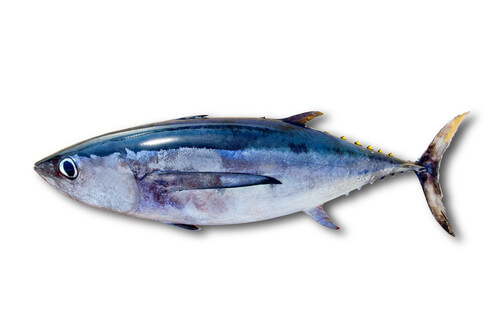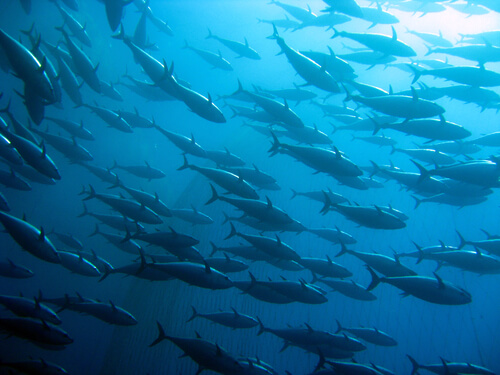
| Kingdom | Animalia |
| Phylum | Chordata |
| Class | Actinopterygii |
| Order | Scombriformes |
| Family | Scombridae |
| Genus | Thunnus |
| Species | T. alalunga |
| Niche | Epipelagic predator |
| Length | Up to 7 ft (1.4 m) |
| Weight | 72 lb (33 kg) |
| Lifespan | 10-12 years |
| Social Structure | Schooling predator |
| Conservation Status | Near Threatened |
| Preferred Habitat | Indian, Atlantic, Pacific Oceans, primarily offshore |
| Average Clutch Size | Millions of eggs |
| Main Food Items and Prey | Fish, crustaceans, squids, etc. |
| Predators | False killer whale, mako shark, great white shark |
The Basics
The albacore tuna is a pelagic, medium-sized predatory fish of the Scombridae family. It can grow up to 7 feet in length and weighs up to 72 pounds. This species is a common target of commercial and sport fisheries and can be found in six separate stocks throughout the world’s oceans.
Description
The albacore tuna is streamlined with a football-shaped body and a large mouth at the end of its cone-shaped head. They also have large eyes and are colored dark blue on their dorsal side and silver-white on their ventral side. Their pectoral fins are quite long in relation to some other tuna species, extending up to 30% of the total length of the fish. They also have two dorsal fins and an anal fin as well as several finlets on either side of its tail and hind section, leading to its large tail or caudal fin.

Distribution and Habitat
There are six distinct stocks of albacore tuna, all of which are found in the Atlantic, Pacific, and Indian Oceans as well as the Meditteranean Sea. This makes the species cosmopolitan throughout temperate and tropical waters around the world. They prefer waters in the range of 50-77 °F and normally inhabit surface waters, diving up to about 2,000 feet deep at times.
Tuna are often schooling, and albacore is no exception. They will normally school with other members of their same species, but also with other similarly-sized schooling fish such as skipjack tuna. They also travel great distances, although separate stocks do not seem to mix.
Diet
The albacore tuna is a streamlined, fast-swimming fish. Like all species of tuna, this allows it excellent predatory abilities. They use their speed along with their keen eyesight and large mouths to catch their prey. However, unlike most other species of tuna which subsist primarily on fish, the albacore tuna has a diet consisting mostly of cephalopods such as squid, octopus, and cuttlefish. They will also feed on fish and various pelagic crustaceans, although the details of their feeding behavior are not well known due largely to their diving behavior in which they will dive to depths of up to 2,000 feet, normally at night, presumably to feed.
Reproduction
The albacore tuna is oviparous, with development occurring externally. Normally between November and February, females will broadcast spawn, releasing large amounts of eggs into the water. An adult female can produce more than two million eggs at a time, and their release will normally occur in synchronization with the release of sperm into the water column by males.

Once the egg is fertilized, the embryo develops as part of the zooplankton community, traveling the ocean at the mercy of the currents. Fry will normally remain close to their spawning area, eventually moving on after reaching about 12 months in age. Most individuals reach reproductive maturity around 5-6 years of age and normally live about twice as long, to about 12 years.
Conservation Status
Like other tuna species, the albacore tuna is highly migratory as an adult, traveling steadily over great distances in the oceans. This makes them a difficult stock to manage, protect, and regulate, as it requires international cooperation in policy and enforcement over many jurisdictions. As a result, tuna are often overfished, including the albacore tuna which is of high demand and often targetted by both commercial and sport fisheries. Currently, the species is listed as Near Threatened by the IUCN Red List of Threatened Species.
Fun Facts about the Albacore Tuna!
Although the albacore isn’t the largest or most commercially valuable of all tuna species, it is still an impressive predator that travels great distances and comprises a large part of the GDP of several Pacific nations. Indeed, there are many fun facts and interesting insights to be explored through the albacore.
The Traveling Tuna
Most tuna species are highly migratory. In the case of the albacore tuna, each stock has its own migratory pattern. For example, the North Pacific stock migrates between the temperate waters of the Pacific Northwest and coastal British Columbia, Canada, and the subtropical waters of Baja California, Mexico. Meanwhile, the North Atlantic albacore stock travels to the Bay of Biscay near France and Spain in synchrony each year.
Some Like it Hot
Fisheries management is a complicated and challenging endeavor. This is true for tuna as much as any other species. Not only are they highly sought after, but their ranges are vast, requiring cooperation between dozens of jurisdictions in order to manage stocks.

In addition, the fish’s ecology, including its population dynamics are apparently variable between stocks. For example, it has been found that older fish tend to be caught in cooler waters in the Atlantic Ocean, whereas the opposite is true for the Pacific Stock, with older fish being found in warmer waters and schools generally aggregating near interfaces between warmer and cooler waters. This, of course, is all occurring in the context of global climate change which is causing the oceans to warm. This has affected the timing of spawning and migratory events as well as the actual range and distribution of many species, including the albacore tuna.
Ever-Ready
Like other tuna species, the albacore tuna never truly rests. In addition to being an endotherm or ‘warm-blooded’, it also needs to keep its large muscles oxygenated at all times in order for them to be useful when needed. The demand of these muscles requires the tuna to be constantly moving to pass water over its gills and, in turn, oxygen into its bloodstream.
Asymmetrical Gonads
Interestingly, most albacore tuna have asymmetrical gonads. In males, the right teste is larger than the left teste. In females, the right ovary is larger. Not only are their sexy organ asymmetrical in time, but they also display asynchronous oocyte development, in which the female’s eggs do not develop at a fixed frequency. Also, eggs at various stages of development will be present within the female at any given time, particularly within the spawning season.
